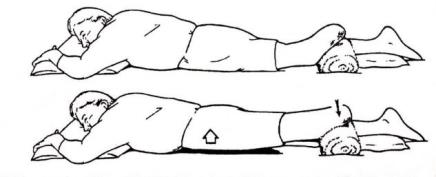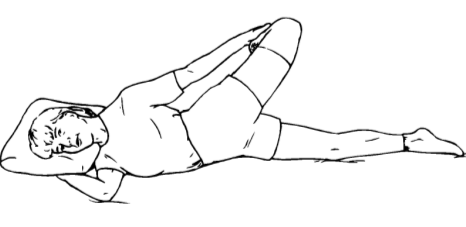Goals of Physiotherapy
- Prevent complications with prolonged bed rest.
- Gradual and safe return to movement in daily activities.
- Maintain or optimise range and strength of the operated limb.
During Bed Rest, with or without Surgery:
| Reduce risk of chest infection with prolonged bed rest with this exercise
Take 10 deep breaths hourly. Your abdomen should rise more than your chest.
| 
|
| Deep vein thrombosis can be prevented by promoting blood circulation to your legs.
Flex your unaffected foot/limb up and down 10 times hourly.
|

|
If you would like to turn in bed but are unable to do so on your own, please do get assistance from the healthcare personnel available. Turning in bed every 2-3 hourly helps prevent pressure sores from forming on your skin.
Amputee Exercise:
Sound (Non-Amputated) & Residual (Amputated) Limb
|
Inner Range Quads
Place a bolster under the knee of the sound limb or from a seated position, tighten muscle on top of thigh and straighten leg. Hold 10 seconds. Repeat 10 times.
| 
|
|
Straight Leg Raise
Support residual limb Tighten muscles on sound limb and lift leg up 10 inches while keeping knee locked. Hold 10 seconds. Repeat 10 times.
|  |
| Hip Abduction
Lie on residual limb side. Tighten muscles on outside of hip to raise sound limb as high as possible Hold 10 seconds. Repeat 10 times. |  |
| Quads Stretch
Lie on residual limb side. Pull foot straight back toward buttocks until a stretch is felt in front of thigh. Hold 10 seconds. Repeat 10 times. |  |
|
Hamstring Stretch
Sit with back straight, sound limb out in front with knee straight. Lean forward until a stretch is felt in back of thigh. Hold 10 seconds. Repeat 10 times. |  |
|
Calf Stretch
With towel around forefoot, keep knee of sound limb straight and pull back on towel until a stretch is felt in the calf. Hold 10 seconds. Repeat 10 times.
|  |
Amputee Exercise: (Below Knee)
|
Hip/Knee Flexion and Extension
Roll to sound side. Bring knee to chest while bending hip/knee Reach residual limb back as far as possible while straightening knee Repeat 10-20 times
|  |
| Hip Abduction
Roll to sound side. Lift residual limb straight up. Hold 10 seconds. Repeat 10 times.
|  |
|
Hip Adduction
With towel roll between thighs Gently squeeze thighs together and down. Hold 10 seconds. Repeat 10 times. |  |
Static Quads
With towel roll under back of residual limb, tighten thigh muscles to straighten knee. Gently push down while tightening buttock muscles. Hold 10 seconds. Repeat 10 times.
|  |
Inner Range Quads
With towel roll behind knee Gently straighten knee over the towel roll. Hold 10 seconds. Repeat 10 times.
|  |
| Static Hip Flexion/Quads
With towel roll under shin of residual limb, tighten thigh muscles to straighten knee.
Push down into towel roll while lifting hips. Hold 10 seconds. Repeat 10 times.
|  |
Amputee Exercises ( Above Knee)
Hip/Knee Flexion and Extension Roll to sound side. Bring knee to chest while bending hip/knee Reach residual limb back as far as possible while straightening knee Repeat 10-20 times
|  |
| Hip Abduction
Roll to sound side. Lift residual limb straight up. Hold 10 seconds. Repeat 10 times.
|  |
|
Hip Adduction
With towel roll between thighs Gently squeeze thighs together and down. Hold 10 seconds. Repeat 10 times. |  |
Hip Extension
With towel roll under residual limb, push down into towel roll while lifting buttocks. Hold 10 seconds. Repeat 10 times.
|  |
Abdominal crunch Tighten stomach muscles to tilt pelvis and flatten back. Raise head and shoulders, and slide fingers up thigh toward knee. Continue breathing normally. Hold 10 seconds. Repeat 10 times.
|  |
| Prone hip flexion
With towel roll under shin of residual limb, tighten thigh muscles to straighten knee. Push down into towel roll while lifting hips. Hold 10 seconds. Repeat 10 times.
|  |
Flexibility Exercises
Below Knee Amputation stretches
|
Hamstring stretch
Place sound foot on the floor, keep back and residual limb knee straight. Lean forward until a stretch is felt in back of residual limb thigh. Hold ____ seconds. Repeat ____ times.
|  |
|
Hip Flexor stretch
Reach back and grasp residual limb. Pull toward buttocks until a stretch is felt in front of thigh. Hold ____ seconds. Repeat ____ times.
|  |
| Adductor stretch
Sit with your back against the head of your bed. Put your amputated limb out to the side and bend the other leg slightly. Push on the thigh, so you feel a stretch in your inner thigh. Make sure that both buttocks remain on the bed. Do not lift one up in the air. Hold ____ seconds. Repeat ____ times.
|  |
Above Knee Amputation stretches
| Hip flexor stretch
Lie on your stomach. Place a rolled towel under your amputated limb. Lie in this position for 20 minutes. As you stretch the hip flexor muscle, you may increase the size of the towel roll. Hold ____ seconds. Repeat ____ times
| 
|
Amputee Exercises ( Upper limb)
|
Dips
With hands on armrests of chair, raise sound foot off floor. Press down with arms to lift body until arms are straight. Hold ____ seconds. Repeat ____ times. |  |
| Arm Lift
Sitting with hands on opposite thighs, breathe in deeply while raising arms up and apart, thumbs pointing behind. Lift rib cage. Breathe out slowly while lowering and crossing arms. Relax. Hold ____ seconds. Repeat ____ times.
|  |
|
Shoulder Retraction
With exercise band held in front, keep elbows at side while rotating hands apart and pulling shoulder blades back. Hold 10 seconds. Repeat 10 times. Hold ____ seconds. Repeat ____ times.
|  |
| Shoulder Press
With exercise band attached behind, press arms forward until elbows are straight. Hold ____ seconds. Repeat ____ times.
|  |
|
Biceps Curl
With exercise band under front wheels or legs of chair, alternate curling each hand up toward shoulder. Hold ____ seconds. Repeat ____ times.
|  |
Types of Sensation
Perception of pain may be from the operation site or a sensation from where your limb used to be.
Phantom Sensation
- Feeling that your limb is still there.
Phantom Pain
- Tingling, burning, and/or cramping sensation.
Residual limb pain
- Pain arising from area where there is no limb.
- Pain that originates in the part of your limb that remains. It can be caused by swelling, nerve damage or irritation from your prosthesis.
Pain Management
- Keep a diary to track symptoms
- Make a list of all medical information (diagnosis and treatments)
- Prepare questions before consultation
- Pain Management after surgery includes nerve block/ epidural block/ spinal block/oral pain medication. Your doctor will advise on which is suitable for you
- You will be advised on cryotherapy (ice), compression bandage and elevation of operated limb to reduce pain and swelling
- Relaxation and music therapy have also been effective
Wound healing
Rate of wound healing differs for each individual patient. An appropriate amount of rest after surgery is expected to assist in initial wound healing. Thereafter, generally keeping active and adopting a healthy lifestyle accelerates later stages of wound healing.
Related
